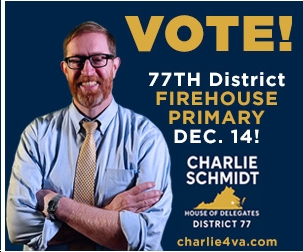By Josh Stanfield of Activate Virginia
Over the past few months, I’ve been going back and forth with Gene Magruder on this question: will we see Democratic House of Delegates candidates, particularly in districts affected by the proposed fracked-gas pipelines, earn more votes than Ralph Northam in their districts? Both Gene and I have assumed that, in general, the gubernatorial candidate will earn more votes than a down-ballot House candidate of the same party in any given district.
Yesterday I examined that assumption by looking at the 2013 Democratic returns.
Notes on Methodology
Before I go into the data, I want to emphasize yet another negative effect of gerrymandering: it can make data analysis incredibly tedious. If our House of Delegates districts were a bit more – what’s the word – compact? – the following analytical problems wouldn’t be so cumbersome.
I was able to get the official 2013 vote counts for House of Delegates candidates from the Virginia Department of Elections. Acquiring accurate McAuliffe vote counts within House districts, however, is more difficult. Because we have so many split precincts in Virginia (precincts within more than one House/Senate district), and because the Department of Elections tabulates absentee and provisional ballots by locality, we don’t know exactly how many votes the statewide candidates earned in each House of Delegates district.
I used two sources for the 2013 McAuliffe numbers within House districts: VPAP and Daily Kos. When presenting statewide returns within a House district, VPAP includes the following disclaimer:
“Because the State Board of Elections does not compile district-specific results in statewide elections, VPAP has calculated and estimated the results based on available information. VPAP’s formula is based on the following:
Split Precincts: Results in statewide elections are apportioned in precincts split among two or more legislative districts based on the number of votes cast in each district during the most recent legislative elections.
Absentee Ballots: Absentee ballots are included only from localities that fall within a single House or Senate district.
Provisional Ballots: Provisional are included only from localities that fall within a single House or Senate district.”
I’m not sure about the Daily Kos formula for tabulating the statewide candidate returns within House districts, but as you’ll see below, the Daily Kos numbers tend to be higher than those from VPAP. I’m going to assume the real vote count is somewhere in between.
The Numbers
In the sheet below you’ll find the vote counts for 2013 House districts in which both major parties competed at the House of Delegates level. You can view the sheet separately here – see the “2013” tab.
Via VPAP
As you can see, if we accept the VPAP vote counts for Governor McAuliffe, the results are surprising and counterintuitive.
Democrats ran candidates for the House in 67 districts. In 54 of those districts, the Democratic candidate received more votes than did McAuliffe. That’s a whopping 81% of Democratic House candidates who outpolled the Democratic gubernatorial candidate in their districts. Of those 67 candidates, all 16 unopposed Democrats and all 8 Democrats with only third party challengers outpolled our current Governor. Of the 43 candidates in competitive races, 30 outpolled McAuliffe.
When we look at the 43 competitive House races, we find another interesting set of numbers. In 40 of those 43 districts, more total votes were cast for the House of Delegates contest than for the gubernatorial contest. That’s about 93%.
Via Daily Kos
The Daily Kos gubernatorial numbers – however they’ve been calculated – are higher than those from VPAP. Of the 67 districts in which Democrats ran, the House candidates received more votes than did Terry McAuliffe in 40 districts. That’s 60% of Democratic House candidates who outpolled the Democratic gubernatorial candidate in their districts. Of those 67 candidates, all 16 unopposed Democrats and 6 out of 8 Democrats with only third party challengers outpolled McAuliffe. Of the 43 candidates in competitive races, 18 outpolled McAuliffe.
And when we look again at the 43 competitive House races, we find that in 7 of those districts more total votes were cast for the House of Delegates contest than for the gubernatorial. That’s about 16%.
The Meaning
I’d caution not to come to any paradigm-altering conclusions based solely on these numbers. We should probably look at several sets of data from different gubernatorial years – and also examine the vote counts for other statewide candidates.
It’s possible that 2013 is an anomaly – after all, both Governor McAuliffe and AG Herring won by razor-thin margins. By most accounts, Ralph Northam’s opponent wasn’t credible; the campaign was thus a relative cake walk, and the results indicate as much. As Paul Goldman and Mark Rozell point out in The Hill, “Since 1977, with one exception, the incumbent president’s party loses the Virginia gubernatorial election the next year.”
That exception was 2013.
But these numbers are still surprising: 60-81% of Democratic House candidates outpolled Terry McAuliffe in their districts? How do we explain this phenomenon? I’m not inclined to lazily conclude there was a “reverse coattails” effect, as the dynamics are surely too complex to be captured by such a simple concept. Regardless of any hypotheses we come up with (please include them in the comments), the numbers aren’t what many of us would expect.
2017 Contests
So what does this mean for 2017? Many of us who played roles in recruiting Democratic House candidates over the past year expected robust statewide competition to help our Democratic candidates for Governor, LG, and AG. If you have candidates knocking doors and engaging voters in districts previously uncontested, the logic goes, you’ll necessarily bring some voters to the polls who otherwise wouldn’t go. And hopefully some of those voters will decide to vote for the entire Democratic ticket. This effect is arguably more palpable in locales that, as a result of strategy, don’t get much attention from statewide candidates. Although the 2013 numbers likely indicate some degree of crossover voting, that more total votes were cast in some House contests than in their respective gubernatorials presents the possibility of voters coming to the polls specifically to vote in the House elections. Again – without a more robust analysis, this remains simply a possibility.
Back to my original conversation with Gene – what will happen in pipeline districts? This question doesn’t have to be considered within the context of critiquing candidate positions on the projects. Tom Perriello’s primary run was of value (aside from many other reasons) because the primary results provide a set of data that helps us envision a Democratic statewide coalition. Along those same lines, I’m curious to see how many voters support Justin Fairfax and anti-pipeline Democratic House candidates in these districts. The Northam campaign has surely run the numbers and doesn’t believe there are enough anti-pipeline votes to affect the outcome. But if we see a noticeable split in these districts, we should recognize this as an indicator of potential. Potential to – if we incorporate the interests of citizens who don’t live in the “urban crescent” – form a Democratic coalition that will win statewide contests for the foreseeable future.
[Note: Ben Tribbett notified the author that – in fact – both the VPAP and Daily Kos statewide numbers by HoD district are inaccurate given the provisional/absentee/split precinct problems. I manually calculated the statewide count in HD 34 (2013), and the McAuliffe count was around 500 votes above the DailyKos number.]
















